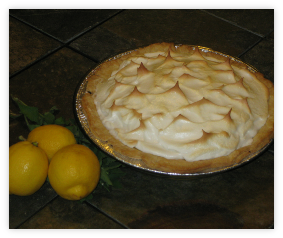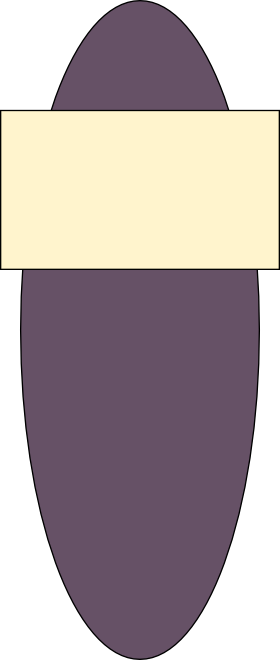


meringue - a mixture of egg whites and sugar beaten until stiff, cooked, and used as a topping for pies


Use a very clean glass or metal bowl, don't allow a single drop of oil or yolk, and don't make a meringue if it's humid outside (or inside).

A basic meringue is just egg whites and sugar. Sometimes an acid, such as lemon juice or cream of tartar, is added to stabilize the egg foam. (Note: Don’t use acids in a copper bowl – they can cause a reaction and discolor the meringue.)
Basic Meringue
4 egg whites
2 tablespoons sugar
Optional: Add 1/8 tsp of cream of tartar or baking soda (this will produce a higher meringue) or lemon juice per egg white to the unbeaten eggs (all meringues eventually fall - this will keep the meringue firmer longer).
Whip egg whites to medium-soft peaks. Beat in 2 tbsp white sugar (and cream of tartar or lemon juice) per egg white. Beat until egg whites are glossy and hold a firm peak.
TIP: You can tell if the sugar is fully dissolved by rubbing a little of the mixture between your fingers. If it feels gritty, the sugar isn´t dissolved yet.
Meringue Troubleshooting:
Shrinking: Use a cornstarch and water mixture to form a gel: beaten gradually into a meringue, the thickener will prevent shrinking problems. Also, make sure to spread the meringue all the way to the edges of the pie, forming a seal.
Weeping: "Weeping" is when water seeps between the meringue and the filling. To prevent weeping, spread the meringue over hot filling, and spread to the edges to seal. Hot filling ensures that the inside of the meringue cooks, preventing weeping. (Swiss or Italian meringues, since they are already cooked, are less prone to shrinking and weeping.) Alternatively, crumbs (cake, crust, cookie, etc.) over the filling and under the meringue to absorb liquid between the layers. Also, try leaving the meringue in the oven until it cools (turn the oven off before it is finished baking so it doesn't over-cook).
Beading: "Beading" is when water droplets form on top of the meringue. This is usually caused by over-baking the meringue, causing the egg whites to tighten, squeezing out moisture. Bake meringues until they are just dry to the touch. Cook at a high temperature (400-425) for a short time (4-5 minutes). You may need to cook the pie first, then add the meringue at the end of the cooking time.
Limp or Soggy Meringue: Humidity affects a meringue's texture. Damp, humid air can cause meringues to be limp and sticky, so ideally meringues should be made in a dry environment. If that is not an option, use a cornstarch and water mixture to form a gel and beat gradually into the meringue.
HOW MERINGUE WORKS:
Beating or whisking causes the protein in the egg whites to unravel, forming films that trap air bubbles. The longer the mixing time, the smaller and more numerous the bubbles, which increases the volume and makes a more-stable structure (however, mixing too long will cause the strands to break and the bubbles to break back down). Sugar adds structure to stiffen the foam. The amount of sugar in the meringue determines how hard or soft the final product will be. It is very easy to underestimate the size of the bowl you will need. Keep in mind - a beaten egg white can increase to 8 times its original volume.)
Italian meringues are made with syrup instead of sugar.
Swiss meringues are made by combining the sugar and un-whipped egg whites, then heated in a double boiler before whipping. Swiss Meringues are used for icing or cookies.
Meringue How To:
Use a clean, dry bowl. The bowl must be completely grease-free – the slightest trace of fat can ruin a meringue. Use glass, ceramic, stainless steel, or copper bowls. Plastic bowls may appear clean but usually retain residual amounts of oils, so don’t use them for meringues. TIP: Wipe your bowl with a little lemon juice first to clear it of any oily residue.
Cold eggs separate more easily, but room temperature eggs whip better. Separate the cold eggs, and then set them aside for 10 or 15 minutes.
Separate each egg into two bowls - one for the white and one for the yolk, and then add the white portion to the larger bowl. This allows you to reserve any with broken yolks for another purpose. Even a small amount of yolk can deflate the egg whites, so be careful not to break them.
Adding sugar early in the beating process results in a firmer, finer-textured meringue.
TIP: the meringue will be tall, so make sure it won’t hit the top of the oven when you bake it.